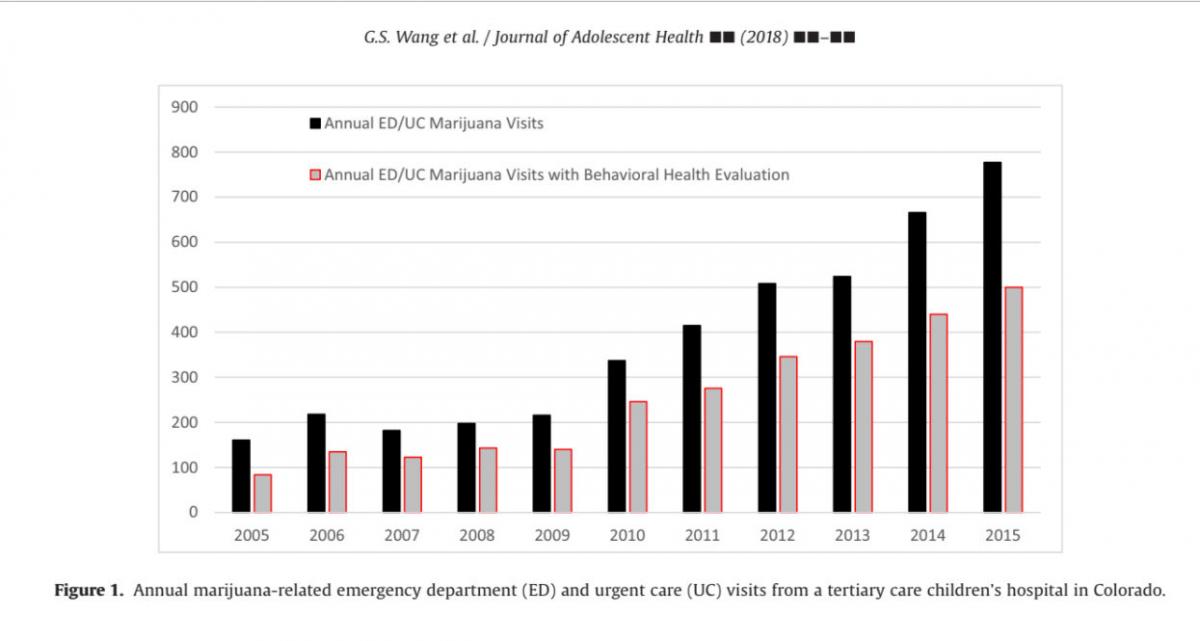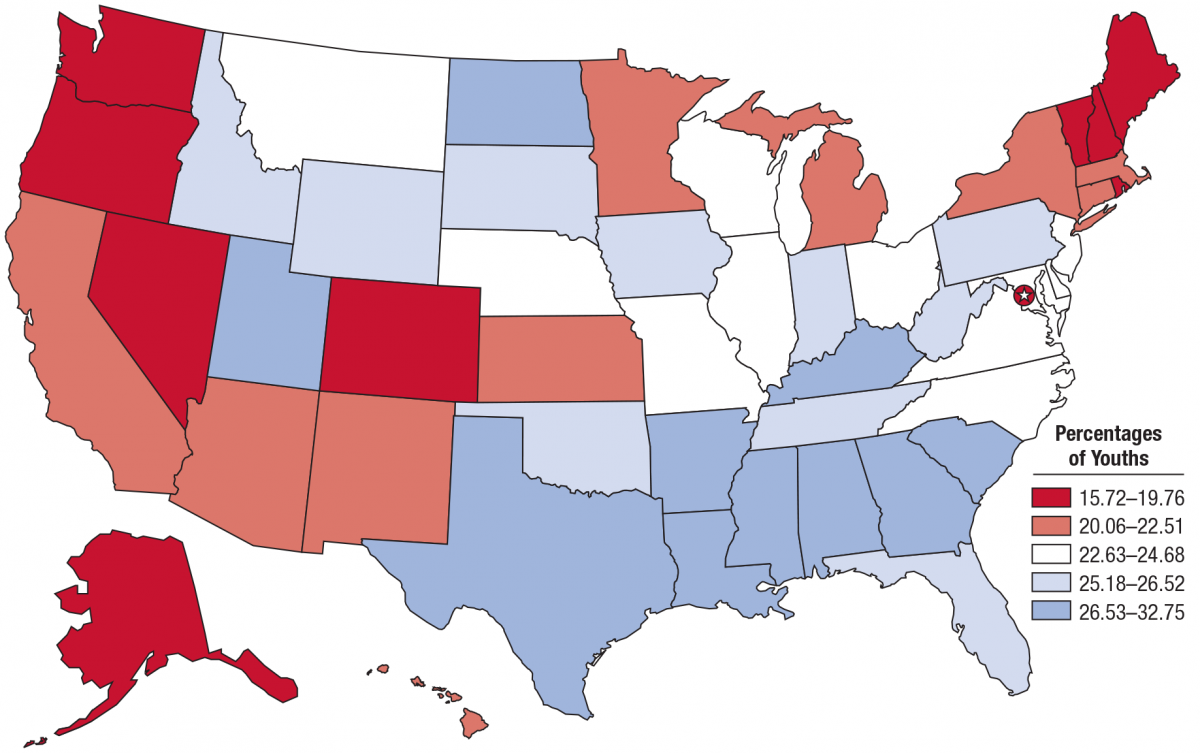Impact on our Youth
| Link | Article Date | Tags | Body |
|---|---|---|---|
| We need to talk about marijuana’s potential harm to youths | 10/14/2022 | students, mental health, youth usage, washington post |
One study shows nearly half of college students said they consumed marijuana. Eight percent reported they used it daily or nearly every day. One in 5 high school students used marijuana in the preceding 30 days. But there are real dangers associated with the substance, as a 2020 report from the National Institute on Drug Abuse (NIDA) shows. Abundant research demonstrates how exposure to marijuana during childhood impacts later cognitive ability, including memory, attention, motivation and learning. Studies have linked regular cannabis use in adolescents with lower IQs in adulthood and higher propensity to drop out of high school. This association persists in college-age students. One large study followed college students and found frequency of marijuana use to correlate with skipping classes, lower grade-point average and longer time to graduation.
|
| Long-term effects of prenatal cannabis exposure: Pathways to adolescent and adult outcomes | 06/26/2022 | Pregnancy, adolescent |
Highlights |
| Johnnys Ambassadors- Mental Illness and Marijuana | 01/14/2022 | Johnnys Ambassadors, mental health, cannabis-induced psychosis, Psychosis, youth |
Articles on link between mental illness and marijuana |
| Adolescent cannabis use and later development of schizophrenia: An updated systematic review of longitudinal studies | 01/01/2022 | mental health, Schizophrenia, youth |
Both high- and low-frequency marijuana usage were associated with a significantly increased risk of schizophrenia. The frequency of use among high- and low-frequency users is similar in both, demonstrating statistically significant increased risk in developing schizophrenia. |
| Cannabis use may be associated with suicidality in young adults | 06/01/2021 | youth, suicide, NIH, study, Research |
An analysis of survey data from more than 280,000 young adults ages 18-35 showed that cannabis (marijuana) use was associated with increased risks of thoughts of suicide (suicidal ideation), suicide plan, and suicide attempt. These associations remained regardless of whether someone was also experiencing depression, and the risks were greater for women than for men. |
| The Real Cost of Vaping | 02/22/2020 | scholastic, Vaping, teacher, students |
As an educator, you can play an active role in fighting the teen vaping epidemic. FDA research suggests that when teachers talk about the health consequences of e-cigarettes and schools enforce anti-vaping policies, students may be less likely to vape. Use these resources to start an honest conversation with your class and help to change social norms at your school. |
| Active cannabis marketing and adolescent past-year cannabis use | 10/09/2019 | Media, youth |
A new study finds that approximately one in three adolescents were exposed to marijuana promotions on social media or had a favorite marijuana brand. |
| 2019 Florida Youth Substance Abuse Survey | 10/09/2019 | Florida, youth, Survey | |
| Teens who use concentrated marijuana more likely to use other drugs | 08/26/2019 | consentrates, Teens, adolescent, Vaping |
In the study, published Monday in the journal Pediatrics, researchers surveyed almost 50,000 adolescents in Arizona. The researchers found that among teens who used any form of cannabis, 72 percent had experience with the more potent products. Overall, the researchers found that 33 percent of the teens had tried some form of pot and 24 percent said they had used concentrated forms. The likelihood of a student using cannabis rose with age: 20 percent of the eighth graders said they’d used the drug, compared to 35 percent of the 10th graders and 46 percent of the 12th graders.
Similarly, 15 percent of the eighth graders, 25 percent of the 10th graders and 33 percent of 12th graders said they had used cannabis concentrates. Concentrate users had the highest rates of having tried other drugs.
|
| Moving beyond perceived riskiness: Marijuana-related beliefs and marijuana use in adolescents. | 08/01/2019 | youth, perception |
Conclusions: Marijuana use varied in association with beliefs about its beneficial and harmful health properties. Clinical interventions that target specific marijuana-related health beliefs including unfounded claims of benefit may provide robust talking points for centering provider guidance and public health messaging. |
| Paulding County teen undergoes CPR after vaping at school | 05/05/2019 | Vaping, Georgia, adolescent |
A Paulding County student collapsed and nearly died after taking a hit off a vape pen. The dramatic scene unfolded in front of a class when the South Paulding High School student collapsed and stopped breathing. |
| Doctor: Marijuana, e-cigarettes harmful to teen brains | 09/16/2018 | Potee, youth, cigarettes |
Marijuana concentrates such as shatter, butter or glass have THC concentrations as high as 90 percent. The same high levels are found in edible cannabis products sold in Colorado, packaged to look like popular candy bars and particularly appealing to children. |
| Cannabis use and driving-related performance in young recreational users: a within-subject randomized clinical trial | 07/01/2018 | Canada, Research, study, driving, youth |
We found that among young recreational cannabis users, a regular dose of cannabis had no effect on simple and learned tasks, but its use led to significant impairments on complex and novel driving-related tasks, as well as perceived driving ability and safety, for up to 5 hours after use. The present finding that the first 5 hours after cannabis use affected driving-related performance substantiates the recommendations of Canada’s Lower-Risk Cannabis Use Guidelines, which recommend waiting 6 hours after cannabis use before driving.30 |
| Impact of Marijuana Legalization in Colorado on Adolescent Emergency and Urgent Care Visits. | 04/08/2018 | Colorado, youth, emergency room |
From 2005 to 2015, 4,202 marijuana-related visits were identified. Behavioral health evaluation was obtained for 2,813 (67%); a psychiatric diagnosis was made for the majority (71%) of these visits. Coingestants were common; the most common was ethanol (12%). Marijuana-related visits increased from 1.8 per 1,000 visits in 2009 to 4.9 in 2015. (p = < .0001) CONCLUSIONS: Despite national survey data suggesting no appreciable difference in adolescent marijuana use, our data demonstrate a significant increase in adolescent marijuana-associated emergency department and urgent cares visits in Colorado. |
| Verbal Memory Performance and Reduced Cortical Thickness of Brain Regions Along the Uncinate Fasciculus in Young Adult Cannabis | 04/08/2018 | youth, memory |
Conclusion: This study provides evidence that cannabis use, especially when initiated at a young age, may be associated with worse verbal memory and altered neural development along the UF. Reductions in cortical thickness in regions implicated in memory processes may underlie weaknesses in verbal memory performance. |
| UConn Study: Teenage Pot, Alcohol Use Can Reduce Success Later In Life | 11/08/2017 | youth, chronic |
This study found that chronic marijuana use in adolescence was negatively associated with achieving important developmental milestones in young adulthood. |
| Substance abuse rarely starts with opiate use on its own | 09/02/2017 | School, opioid, opinion |
We therefore must educate our youngsters, parents and educators before any use of marijuana or alcohol begins. We then must identify those individuals for whom marijuana or alcohol use has become problematic, getting them into an effective program of treatment before they progress to more dangerous alternatives. |
| These college students lost access to legal pot — and started getting better grades | 07/25/2017 | academics, Netherlands, access, college graduation, education |
The research on more than 4,000 students, published in the Review of Economic Studies, found that those who lost access to legal marijuana showed substantial improvement in their grades. Specifically, those banned from cannabis cafes had a more than 5 percent increase in their odds of passing their courses. Low performing students benefited even more, which the researchers noted is particularly important because these students are at high-risk of dropping out. The researchers attribute their results to the students who were denied legal access to marijuana being less likely to use it and to suffer cognitive impairments (e.g., in concentration and memory) as a result. |
| Utah's Sheriff Association 2017 Position Paper | 05/20/2017 | Utah, postition statement, Sheriff, Black Market, youth usage, zoning, dropout |
“So called medical marijuana in other states has become a farce and a sham. The average user of smoked medical marijuana has no chronic illness and is a white male in his mid-30s with a history of drug and alcohol abuse. . . In the last 20 years and due to market demand, constant genetic engineering has increased THC potency in marijuana plants, and extraction-concentration methods are becoming extremely popular and widespread. become addicted.”Marijuana is the 2nd leading cause of impaired driving arrests. One in six adolescents trying marijuana will become addicted. |
| Marijuana use and physical dating violence among adolescents and emerging adults: A systematic review and meta-analysis. | 03/18/2017 | meta-analysis, PDV, adolescent, Studies, Research, ncbi |
Findings suggest that marijuana use is associated with a 54% increase in the odds PDV (physical dating violence) victimization, and a 45% increase in the odds of perpetration. CONCLUSIONS: Findings suggest that dating violence is a correlate of marijuana use, and that association is strongest among adolescents (vs. emerging adults) and girls (vs. boys). |
| Letter: Marijuana availability and increased use directly harms our children | 03/12/2017 | adolescent, legalization, opinion |
Adolescent marijuana use has significantly increased in our state post-legalization, as has been documented in numerous studies. Ask any teenager and they will tell you that marijuana use is rampant in our local high schools, which is obviously not surprising given its widespread availability and the perception of its safety. While we can debate the effects on adults, marijuana use clearly has a detrimental impact on a teenager. Read more here: http://www.tri-cityherald.com/opinion/letters-to-the-editor/article13776... |
| Marijuana use in early adolescence may affect verbal IQ | 01/24/2017 | IQ, youth usage, Brain |
"The study suggests that the effects of cannabis use on verbal intelligence are explained not by neurotoxic effects on the brain, but rather by a possible social mechanism," said lead author Natalie Castellanos-Ryan, Assistant Professor at Universite de Montreal in Canada |
| Has Marijuana Legalization Increased Marijuana Use Among US Youth? | 12/28/2016 | youth usage, legalization |
If the changes observed in Washington are attributable to legalization, why were there no changes found in Colorado? The authors suggest that this may have been because Colorado’s medical marijuana laws were much more liberal before legalization than those in Washington. After 2009, Colorado permitted medical marijuana to be supplied through for-profit dispensaries and allowed advertising of medical marijuana products. This hypothesis is supported by other evidence that the perceived risks of marijuana use decreased and marijuana use increased among young people in Colorado after these changes in 2009. |
| DrugFacts—Monitoring the Future Survey: High School and Youth Trends | 12/18/2016 | monitoring the future, 2016, youth usage |
This year, daily marijuana use exceeded cigarette use among 10th (2.5 vs. 1.9 percent) as well as 12th (6.0 vs. 4.8 percent) graders. |
| Medical marijuana is now legal, but still a danger to children | 12/13/2016 | academics, Amendment 2, school board, School |
Research findings on the topic of marijuana use and its impact on people’s health and on society have been mixed; however, in the midst of diverse conclusions, it is essential to err on the side of caution for our community’s youth. According to a publication by the American Psychological Association (APA), short-term marijuana use has been shown to impair attention, memory, learning and decision-making. Read more here: http://www.miamiherald.com/opinion/op-ed/article120529268.html#storylink... |
| 2018 Colorado budget: Gov. John Hickenlooper proposes $28.5 billion plan with deep cuts | 11/02/2016 | Colorado, homeless, students |
The Governor is now proposing new and significant budget cuts for this upcoming legislation session in the following areas: capital construction for our schools, health and human services, public safety/courts, healthcare including Colorado hospitals, and education including K-12 and higher education. Areas that have experienced and reported increased negative impacts and/or costs associated with increased marijuana availability/commercialization. Areas mentioned where marijuana tax revenues will be spent highlight some of the negative impacts from increased marijuana availability/commercialization, and include: "Hiring of more mental health professionals in schools and child welfare caseworkers“ $18 million program to create affordable housing for the homeless" (Denver has reported dramatic increases in student homelessness as has other areas in Colorado.) |
| Educational Outcomes | 11/01/2016 | education, PubMed, Studies |
CONCLUSIONS: |
| Legalized Marijuana Boosts High School Dropout Rates | 10/30/2016 | dropout, college, youth, young adults |
"More than anything, what we have done is provided good, solid evidence that there is a direct link between marijuana policies and education," lead author Andrew Plunk, PhD, from Eastern Virginia Medical School, Norfolk, |
| What Educators Should Know About Marijuana | 09/12/2016 | Infographics, educators, Brain, youth, charts |
KNOW YOUR A,B,C,D’s … Absent, Behavior, Course Grade = Drugs |
| Colorado districts wrestle with new law allowing students to use medical marijuana at school | 08/22/2016 | Colorado, School, School District |
“Ultimately, the school districts can figure it out,” Singer said, “or the state will figure it out for you.” So far, some school districts — including Boulder Valley, Jefferson and Douglas County — are working on policies or have produced them. |
| Colorada approves Medical Marijuana Use at Schools | 08/10/2016 | Colorado, School |
The bill allows a student to use medical marijuana on school grounds, on a school bus, or at a school activity and requires each school district to adopt a policy allowing the medical marijuana use. If the department of education or a public school loses any federal funding as a result of adopting the policy, the general assembly shall appropriate state money sufficient to offset the loss of federal money. http://openstates.org/co/bills/2016A/HB16-1373/
|
| Study: Teens' likelihood of trying marijuana peaks at 16, 18 | 06/29/2016 | youth usage, prevention |
“Many existing marijuana intervention programs target students age 15 and older,” Chen said. “Our findings demonstrate the need to start drug education much earlier, in the fourth or fifth grade. This gives us an opportunity to make a preemptive strike before they actually start using marijuana.” |
| Colorado Youth Marijuana Use: | 06/21/2016 | Colorado, youth usage, School |
|
| Marijuana use in adolescence may increase risk for psychotic symptoms | 06/17/2016 | youth, adolescent, Psychosis |
Analysis indicated that for each year adolescent boys engaged in regular marijuana use, their projected level of subsequent subclinical psychotic symptoms increased by 21% and projected risk for subclinical paranoia or hallucinations increased by 133% and 92%, respectively. |
| Edibles And Concentrates Are Red-Hot, According To Latest Numbers | 06/14/2016 | edibles, Colorado, youth |
"The rapid growth in concentrates and edibles is the continuation of a two-year trend, as consumers increasingly prefer alternative consumption methods to smoking," BDS Analytics CEO Roy Bingham told Civilized in an e-mail. |
| New law requires schools to adopt a medical marijuana policy | 06/06/2016 | Colorado, School, School District |
The law and D49's policy only allows non-smokeable marijuana to be used on school grounds. The medicine would have to be brought, administered, and taken away from the school by the student's primary caregiver. No school employee would be required to give the student cannabis. |
| State Estimates of Adolescent Marijuana Use and Perceptions of Risk of Harm From Marijuana Use: 2013 and 2014 | 05/21/2016 | SAMHSA, youth | |
| Inforgraphics for Educators | 05/11/2016 | Infographics, high school, School, academics | |
| Death of Muslim teen was an accident, not a hate crime, police investigation finds | 05/10/2016 | youth, Death, Washington |
Warsame told his schoolmate he had never smoked marijuana and would like to try it, and the two smoked together, according to the report. A toxicology screen by the medical examiner found “relatively high levels” of tetrahydrocannabinol (THC), the main psychoactive constituent in marijuana, in Warsame’s system. |
| STATE ESTIMATES OF ADOLESCENT PAST MONTH MARIJUANA USE | 04/22/2016 | youth, SAMHSA |
|



